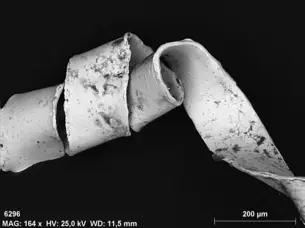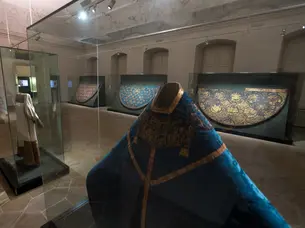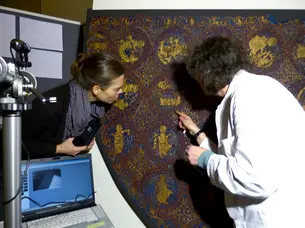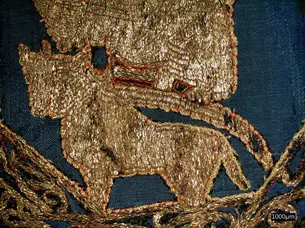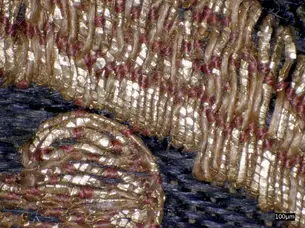The Emperor’s Clothes in Transformation - Gold embroidered staging of the past
Content and aims
The "Emperor’s Clothes" of the Bamberg Cathedral treasury are the oldest preserved textiles of European rulers in the world and for centuries have been firmly associated with the name of the holy imperial couple Henry II († 1024) and Cunegonde († 1033). However, in 1127 only one "Emperor's Robe" was mentioned in the treasure register, which was traced back to the founders of the Bamberg bishopric. In the course of time the number of textiles varied up to more than ten, in the 18th century it was fixed at six vestments.
Not only the liturgical meaning of the vestments was reinterpreted over the centuries. The textiles were also repaired several times and "restored" in sometimes adventurous ways. This went so far as to cut all the gold embroidery from the original backing fabrics and embroider it onto new silk fabrics. This greatly altered the outward appearance of some of the "emperor's robes." It is believed that gold embroideries were partially rearranged to specifically promote the emperor and saint cult of Henry and Cunegonde.
Accordingly, each textile in its present appearance is not only a mixture of different "interpretations" but also, quite tangibly, of different materials from different periods.
The broad-based DFG project is now shedding light on the history of the origin, the craftsmanship and the conception of the content of the "emperor's vestments".
Methodology
On the part of the KDWT, scientific material comparisons of the different gold embroideries, threads, embroideries and fabrics were to clarify in more detail what changes were made to the textiles over the centuries.
For this purpose, all six Bamberg "imperial robes" were sampled, cross-sections of samples were made, and examinations were carried out using light microscopy (LM: Olympus/AX70) and fiber microscopy (FM: Keyence/ VHX- 5000) as well as analytical scanning electron microscopy with energy dispersive spectral analysis (REM: Philips/ XL40; EDS: Bruker/ AXS X-Flash Detector 5010). Further measurements were made with analytical infrared spectroscopy in transmission with diamond cell (FT-IR: PerkinElmer /Frontier/ Spotlight 400) and with mobile X-ray fluorescence analysis (RFA: Analyticon/ Niton XL3t).
The results can now be put into context with textile-technological and art-historical analyses in relation to each other and also to other early Romanesque textiles.
For example, the "Blue Cunegonde Coat" was scientifically examined for grayed gold threads, which are found next to golden ones. This graying results from the corrosion of the metal thread, which does not consist of pure gold, but of silver with a wafer-thin gold layer on top. Over time, the silver diffused through the gold layer and corroded to silver sulfide - and thus to "gray".
These threads, which appear gold but are silver at their core, are also called "Nuremberg" or "intermediate" gold and were probably an inexpensive substitute for pure gold threads. Although known as early as the 12th century, the production of these threads did not become popular until the 15th century. This would fit well in time with the first recorded major restoration of the vestments, in which the gold embroidery was cut out and applied to new silk fabrics.
Also on the "Blue Cunegonde Coat," microscopic whitish particle debris (Sample K11, Fig. 4) was found and analyzed in a gold embroidery on the original backing fabric. It is a mixture of bone ash (hydroxyapatite) and gypsum bound with protein (glue; casein). Based on this composition, pre-painting traces can indeed be assumed.
The mass of painting medium (bone ash and gypsum) and binder may have been painted on wet or used as a solid piece of chalk, similar to a contemporary tailor's chalk. In the case of a liquid application method, it can be assumed that the preliminary drawing substance was prepared warm on site. As chalk, it may also have been offered ready-made in the trade. The use of bone ash was common in many areas of life in the Middle Ages, and it was also used in painting, primarily as a pigment and filler in paints and plaster mortars.
Preliminary drawings were also found, for example, on the "Rider's Coat" and identified as auripigment. This could indicate that this robe may have been made in Italy.
Further investigations were carried out on all "imperial robes". Elemental analytical comparisons, thickness measurements of the gold threads or dye analyses revealed in part great similarities - but also glaring differences.
Now these scientific results must be correlated with the humanistic analyses within the framework of the DFG project in order to further investigate the development of the textiles.

